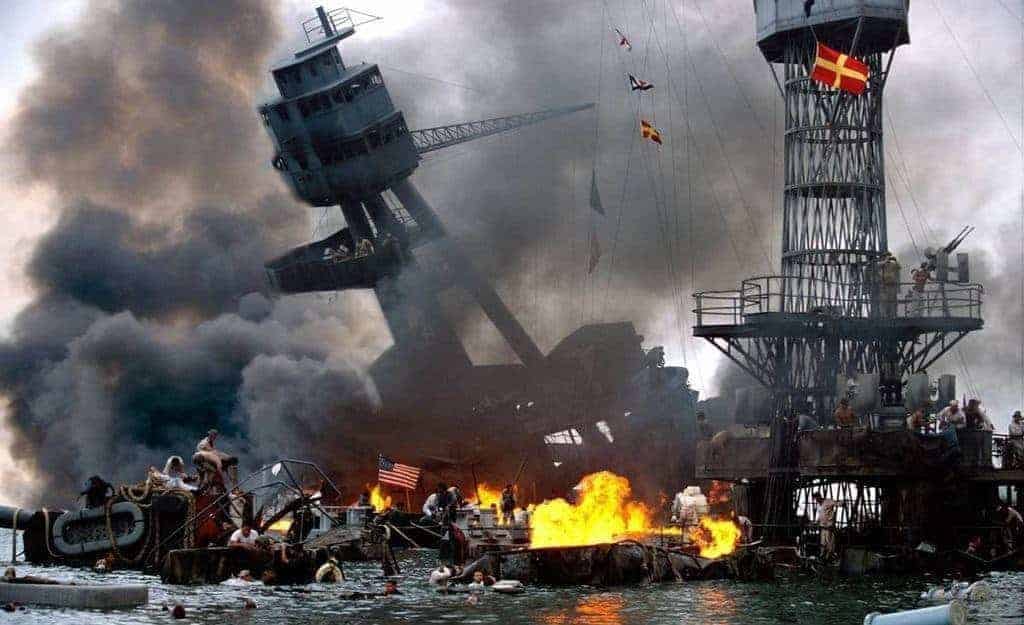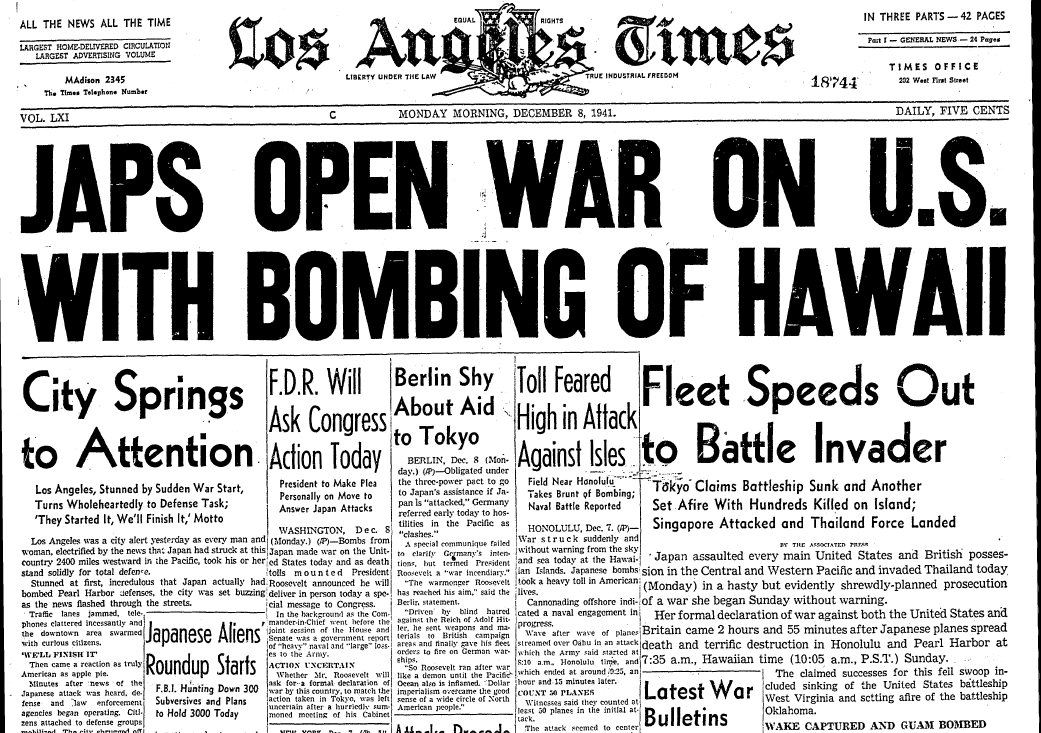As I witness Americans once again dancing to the tune of war drums and I get pushback for not genuflecting at the blue-and-yellow altar, I feel the need to inform. To follow is the second installment of a series of articles highlighting how God’s Country™ has been marketing and using war as a way to fatten the wallets of the powers that shouldn’t be. Please allow me to put the lie to the myths surrounding the sneak [sic] attack on Pearl Harbor.
The Japanese bombing of Pearl Harbor on December 7, 1941, is the mother of all “sleeping giant” myths. The day after the attack, President Franklin Delano Roosevelt addressed Congress. The U.S. was “at peace” with Japan, he stated, yet had been “suddenly and deliberately attacked.”
Yet, as historian Thomas A. Bailey wrote: “Franklin Roosevelt repeatedly deceived the American people during the period before Pearl Harbor… He was like the physician who must tell the patient lies for the patient’s own good.”
The diplomatic record reveals some of what Dr. Roosevelt neglected to include in that now-mythical “Date of Infamy” speech:
•Dec. 14, 1940: Joseph Grew, U.S. Ambassador to Japan, sends a letter to FDR, announcing, “It seems to me increasingly clear that we are bound to have a showdown [with Japan] someday.”
•Dec. 30, 1940: Pearl Harbor is considered so likely a target of a Japanese attack that Rear Admiral Claude C. Bloch, commander of the Fourteenth Naval District, authors a memorandum entitled, “Situation Concerning the Security of the Fleet and the Present Ability of the Local Defense Forces to Meet Surprise Attacks.”
•Jan. 27, 1941: Grew (in Tokyo) sends a dispatch to the State Department: “My Peruvian Colleague told a member of my staff that the Japanese military forces planned, in the event of trouble with the United States, to attempt a surprise mass attack on Pearl Harbor using all of their military facilities.”
•Feb. 5, 1941: Bloch’s December 30, 1940 memorandum leads to much discussion and eventually a letter from Rear Admiral Richmond Kelly Turner to Secretary of War Henry Stimson in which Turner warns, “The security of the U.S. Pacific Fleet while in Pearl Harbor, and of the Pearl Harbor Naval Base itself, has been under renewed study by the Navy Department and forces afloat for the past several weeks… If war eventuates with Japan, it is believed easily possible that hostilities would be initiated by a surprise attack upon the Fleet or the Naval Base at Pearl Harbor… In my opinion, the inherent possibilities of a major disaster to the fleet or naval base warrant taking every step, as rapidly as can be done, that will increase the joint readiness of the Army and Navy to withstand a raid of the character mentioned above.”
•Feb. 18, 1941: Commander in Chief, Admiral Husband E. Kimmel says, “I feel that a surprise attack on Pearl Harbor is a possibility.”
•Sept. 11, 1941: Kimmel says, “A strong Pacific Fleet is unquestionably a deterrent to Japan—a weaker one may be an invitation.”
•Nov. 25, 1941: Secretary of War Henry L. Stimson writes in his diary, “The President…brought up entirely the relations with the Japanese. He brought up the event that we’re likely to be attacked [as soon as] next Monday for the Japanese are notorious for making an attack without warning.”
•Nov. 27, 1941: U.S. Army Chief of Staff George C. Marshall issues a memorandum cautioning that “Japanese future action unpredictable but hostile action possible at any moment. If hostilities cannot…be avoided, the United States desires that Japan commit the first overt action.”
•Nov 29, 1941: Secretary of State Cordell Hull, responding to a speech by Japanese General Hideki Tojo one week before the attack, phones FDR at Warm Springs, GA to warn of “the imminent danger of a Japanese attack,” and urge him to return to Washington sooner than planned.
If it wasn’t a total surprise, why did Japan attack Pearl Harbor?
The events of December 7, 1941, were roughly two decades in the making. In 1922, the U.S. and Britain imposed upon Japan an agreement that the Japanese navy would not be allowed more than 60 percent of the capital ship tonnage of the other two powers. That same year, the U.S. Supreme Court declared Japanese immigrants ineligible for American citizenship, and a year later the Supreme Court upheld a California and Washington ruling denying the Japanese the right to own property. The year 1924 saw the passage of the Exclusion Act — which virtually banned all Asian immigration.
On the economic front, when Japanese textiles began out-producing Lancashire mills, the British Empire (including India, Australia, Burma, etc.) raised the tariff on Japanese exports by 25 percent. Within a few years, the Dutch followed suit in Indonesia and the West Indies, with the U.S. (in Cuba and the Philippines) not far behind. Such moves, combined with Japan’s expanding colonial designs, brought the US and Japan closer and closer to conflict.
When France fell to Germany, the Japanese moved quickly to take military control of French colonies in Indochina (the primary source for most US tin and rubber). On July 21, 1941, Japan signed a preliminary agreement with the Nazi-sympathizing Vichy government leading to the Japanese occupation of airfields and naval bases in Indochina. Almost immediately, the US, Britain, and the Netherlands instituted a total embargo on oil and scrap metal to Japan…tantamount to a declaration of war.
This was followed soon after by the U.S. and UK freezing all Japanese assets in their respective countries. Radhabinod Pal, one of the judges in the post-war Tokyo War Crimes Tribunal, later argued that the U.S. had clearly provoked the war with Japan, calling the embargoes a “clear and potent threat to Japan’s very existence.”
But, if the attack on Pearl Harbor was expected, why were the Americans seemingly caught with their pants down on December 7?
Never underestimate the collective power of arrogance and racism. “Many Americans, including Roosevelt, dismissed the Japanese as combat pilots because they were all presumed to be ‘near-sighted’,” writes historian, Kenneth C. Davis. “There was also a sense that any attack on Pearl Harbor would be easily repulsed.”






My 11th grade history teacher taught our class that the US knew Pearl Harbor was going to be bombed because of a de-coding machine called "MAGIC." "They let it happen as an excuse to join the war," in order to get the country out of an economic slump, he told us! I never forgot that (the word 'magic' helped). It was only in later years I realized this was an 'against the grain' teaching! It was totally normalized to me to say that the US sacrificed lives, lied and re-told history. I already had a strong sense of that (from the more recent atrocities of the Vietnam "War") but it was certainly crystallized by this one teacher when I was 17! Hopefully lots more kids today have elders/teachers/caretakers alerting them about all these false flags, including 9/11, the Cvd narrative, etc! Thanks for the history lesson, Mickey!
Excellent history lesson. Thanks.